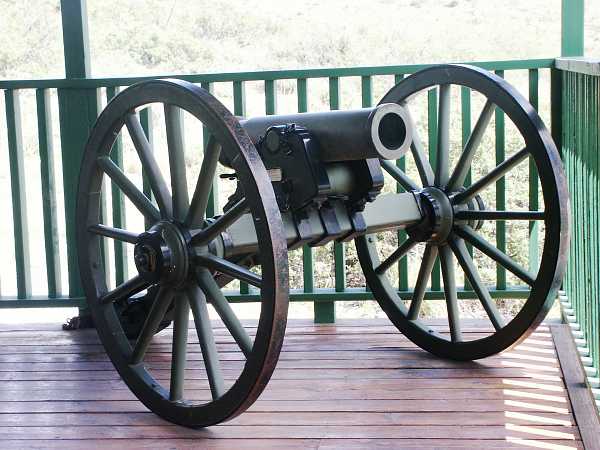
A howitzer is a short-barreled, large-caliber cannon designed to throw shells at a higher trajectory than regular field guns. This makes them useful against enemy troops behind fortifications or concealed in rugged terrain. The mountain howitzer was a special gun, designed on such a small scale that the entire piece could be taken apart and carried on pack animals. Although its 4.62-inch bore could handle the same 12-pounder ammunition as a regular 12-pounder gun, a complete mountain howitzer, including the carriage, wheels and barrel, weighed less than the barrel alone of a larger 12-pounder field gun. Instead of needing a six-horse team like most other Civil War cannons, a mountain howitzer and two ammunition chests could be carried by three mules through trackless forests, across swampy ground, or over rough mountain trails where no other gun could go.

Mountain howitzers figured prominently in several Indian battles fought during the Civil War years, from fighting at Fort Ridgely, Minn., during the 1862 Sioux Uprising to the infamous Sand Creek Massacre in Colorado in 1864. The famous mountain man turned Union general, Christopher "Kit" Carson, credited a pair of mountain howitzers with saving his command during the Battle of Adobe Walls, Texas, on November 25, 1864. Carson's force of about 400 men attacked and overran a Kiowa village before they were confronted by 1,000 Comanche warriors camped nearby. The soldiers barely escaped with their lives after a long, running battle.
Part of Carson's command was a two-gun mountain howitzer section with 26 men of the 1st California Volunteer Infantry, under Lieutenant George Pettis. Pettis' men had traveled on foot to the site of the battle, using horse teams to pull the cannons. A cavalry detachment had remained with them for their protection, and their mountain howitzers proved very useful during the battle. The little cannons forced the Comanche and Kiowa to stay out of their range and remain scattered so as not to make attractive targets.
At one point, Pettis' guns were set up on a sand hill that made a sort of natural fortification. The soldiers loaded them out of sight at the bottom of the hill, then pushed them by hand to the top. A gunner would aim the piece, then lie on his stomach to avoid Indian bullets until he was ordered to fire. When fired, the mountain howitzers violently recoiled, sometimes tumbling over and over and sometimes rolling on their wheels to the bottom of the hill. At last the Indians withdrew, and Carson ordered a return to the expedition's wagon train. The most seriously wounded men were loaded onto the gun carriages and limbers for the journey.
After the war, Pettis met some Mexican traders who had been in the Comanche village on the day of the battle. They told him that the Comanche had said that only "the guns that shot twice" - meaning the mountain howitzers with their exploding shells - had kept them from destroying Carson's entire command that day.
